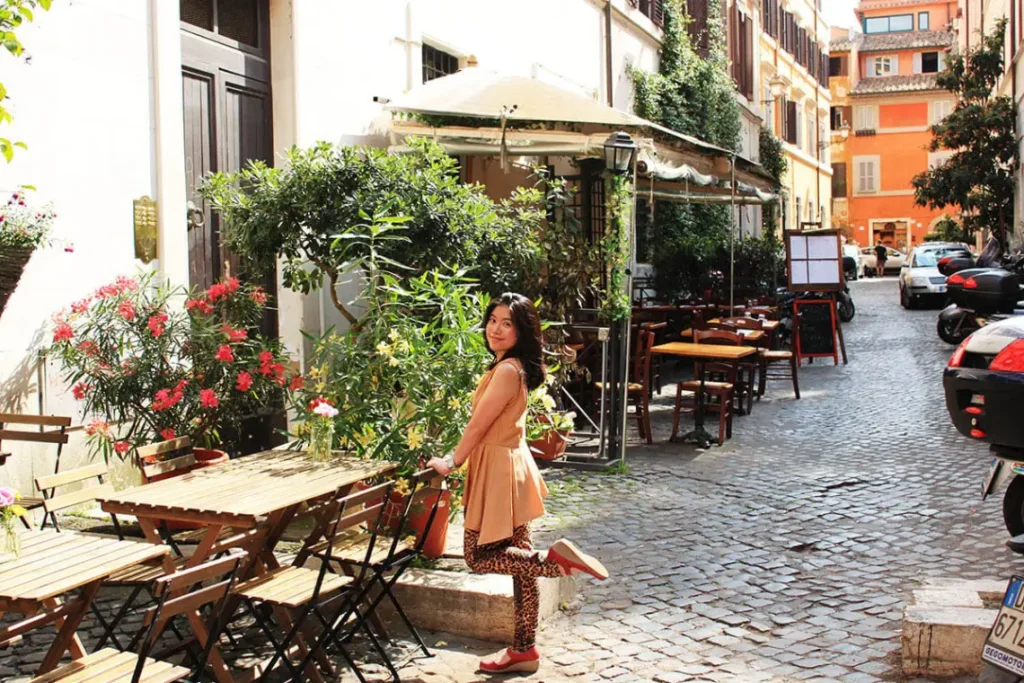Rome, the Eternal City, is an open-air museum filled with centuries of history, breathtaking architecture, and hidden alleyways waiting to be explored. While guided tours offer insightful narratives, there’s something special about setting your own pace and wandering through Rome’s historic streets. A self-guided walking tour lets you linger where you wish, take detours, and immerse yourself in the city’s atmosphere. Here are the best self-guided walking tours of historic Rome, featuring must-see landmarks and lesser-known treasures.
1. The Ancient Rome Walk: Colosseum to Palatine Hill

Start your journey at the Colosseum, Rome’s most famous amphitheater, where gladiators once battled for entertainment. Be sure to walk around the structure to admire its grandeur from all angles. Just across the street, you’ll find the Roman Forum, once the heart of Roman political and social life. Stroll along the ancient paths, imagining the bustling marketplace and grand speeches delivered by Roman statesmen.
Continue up Palatine Hill, the legendary birthplace of Rome. This peaceful area offers fantastic views of the city and an opportunity to explore ruins of ancient palaces. End your tour at the Arch of Constantine, a stunning monument that commemorates Emperor Constantine’s victory.
For those who want to dive deeper, visit the nearby Mamertine Prison, where it’s believed that St. Peter was once held. The prison offers a unique insight into Rome’s early Christian history.
2. The Baroque Rome Walk: From Piazza Navona to the Trevi Fountain

Begin your tour at Piazza Navona, one of Rome’s most famous squares, known for its beautiful fountains, including Bernini’s masterpiece, Fountain of the Four Rivers. Take a moment to enjoy a coffee at one of the outdoor cafés before heading toward the Pantheon, one of the best-preserved Roman buildings, dating back over 2,000 years.
Next, stroll to Piazza di Spagna, home to the Spanish Steps, a popular spot for people-watching and capturing stunning views. Conclude your walk at the Trevi Fountain, where you can toss a coin over your left shoulder to ensure a return to Rome.
For an extended walk, continue to Via del Corso, a major shopping street, or explore the nearby Church of St. Ignatius of Loyola, known for its stunning trompe-l’œil ceiling fresco.
3. The Vatican City Walk: St. Peter’s Basilica to Castel Sant’Angelo

Start your morning at St. Peter’s Basilica, the heart of the Vatican. Inside, you’ll find Michelangelo’s famous Pietà and Bernini’s Baldachin. Don’t forget to climb to the top of the dome for panoramic views of Rome.
Exit the basilica and cross St. Peter’s Square, a magnificent open space designed by Bernini. From here, walk toward Castel Sant’Angelo, a fortress that has served as a papal residence and a prison. Climb to the top for another breathtaking view of the city and the Tiber River.
Extend your walk by crossing Ponte Sant’Angelo, a beautifully adorned bridge with angel statues. This leads you towards Piazza Cavour, where you can see the imposing Palace of Justice and relax in the gardens.
4. The Trastevere Walk: Rome’s Hidden Gem

For a charming and off-the-beaten-path experience, head to Trastevere, a neighborhood known for its medieval alleys and authentic Roman atmosphere. Start at Santa Maria in Trastevere, one of the oldest churches in Rome, adorned with beautiful mosaics.
Wander through the cobblestone streets, stopping for a gelato or aperitivo at a local café. Make your way to Piazza Trilussa, a lively square by the Tiber River, perfect for soaking in the local vibe. End your walk at Janiculum Hill, one of the best places in Rome to watch the sunset.
For a more immersive experience, visit the Orto Botanico di Roma, a lush botanical garden offering a tranquil escape from the city’s hustle.
5. The Jewish Ghetto Walk: A Journey Through Time

Rome’s Jewish Ghetto is a fascinating district filled with history and delicious cuisine. Begin at Portico of Octavia, an ancient ruin once part of a grand complex. Walk through the charming streets to find the Great Synagogue of Rome, a stunning building that tells the story of Rome’s Jewish community.
Don’t miss trying carciofi alla giudia (Jewish-style fried artichokes) at one of the local restaurants. Finish your walk at Ponte Fabricio, Rome’s oldest bridge, leading to the small and peaceful Tiber Island.
For an extended tour, visit the Teatro di Marcello, an ancient theater often compared to a mini Colosseum, offering a glimpse into Rome’s entertainment past.
Tips for a Successful Self-Guided Walking Tours of Historic Rome
- Wear comfortable shoes – Rome’s streets are cobbled, so good footwear is essential.
- Start early – Mornings are less crowded, making the experience more enjoyable.
- Stay hydrated – There are free water fountains (nasoni) scattered across the city.
- Use offline maps – Google Maps or apps like Rome2Rio can help you navigate without using data.
- Take breaks – Stop for espresso, gelato, or aperitivo to soak in the atmosphere.
- Carry cash – Some small eateries and historic sites may not accept credit cards.
- Learn basic Italian phrases – This can enhance your experience and interactions with locals.
Conclusion
Exploring Rome on foot is one of the most rewarding ways to experience its history, culture, and beauty. Whether you’re wandering through ancient ruins, discovering Baroque masterpieces, or uncovering hidden corners of Trastevere, a Self-Guided Walking Tours of Historic Rome, allows you to see the city in an intimate and personal way. So lace up your walking shoes, grab a map, and start your Roman adventure!
FAQs
1. How long does a self-guided walking tour of Rome take?
Each tour varies, but most take 2-4 hours, depending on how much time you spend at each site.
2. Is it safe to walk around Rome at night?
Yes, Rome is generally safe for walking, especially in well-lit tourist areas. However, always be mindful of your surroundings.
3. Do I need a ticket for all historic sites?
Some sites, like the Colosseum and Vatican Museums, require tickets. Others, like the Pantheon and Trevi Fountain, are free to visit.
4. What is the best time of year to visit Rome for walking tours?
Spring (April-May) and autumn (September-October) offer pleasant weather and fewer crowds.
5. Can I do a self-guided walking tour with kids?
Yes! Plan shorter routes, take breaks, and bring snacks to keep kids engaged and comfortable.



